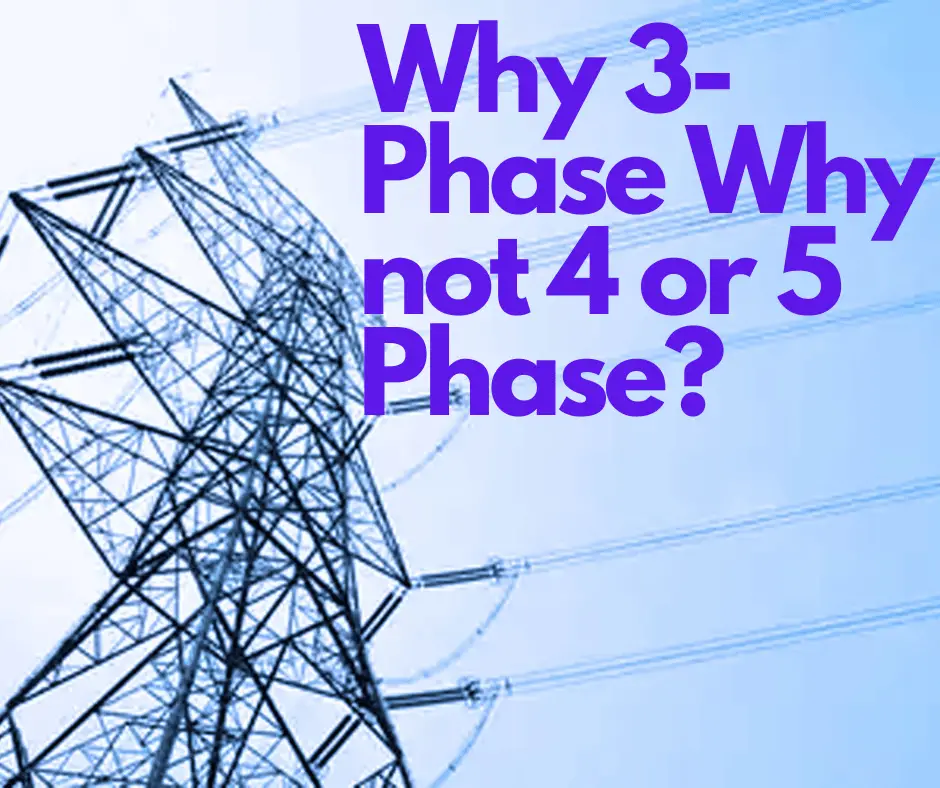Why 3-Phase Why not 4 or 5 Phase is the question that always arises in the mind of an electrical professional. But, there are no specific reasons for the use of the three-phase system. We can use a two, three, four, or six-phase electrical system.
Sometimes, electrical professionals, engineers & scientists try to substantiate that the number three is the closest integer to pi ( 3.14159 . . .) or the base of the natural logarithm system ( 2.78182 . . .). and this could be the reason for the use of the three-phase system, however, it doesn’t.
The fact is that the first few electric generators, built near the end of the 19th century, had three-phase loops in them, probably because three was seen as a good trade-off between two and three-phase, which would leave a perceivable gap on each side of the generator, and four or more, which lead to manufacturing complexity, a real issue before the advent of standardized parts and assembly line production.
The three-phase system proved reasonably efficient and easy enough to work in comparison to other numbers of phases, therefore it became Since three phases proved reasonably efficient and easy enough to work with, in fact, it became a standard, and then the official one, until today all power systems are standardized on three phases.
For esoteric special reasons, six-phase transmission lines, special generators, or equipment are used in certain industrial processes that require nine, twelve, or even fifteen-phase power.
Thus, the power systems have three phases just because they do.
Let us discuss in more detail to clarify the reason why 3-Phase why not 4 or 5 Phase.
Why is Three-Phase System more Economical?
In fact, a three-phase system has more efficiency than a two-phase and three-phase system. The copper loss reduces by about 75 % in a three-phase system compared to a copper loss in a single phase. The more phases further reduce the copper loss however reduction is marginal. The drawback of more phases is that the transmission towers have to sustain more loads of conductors. Thus, the cost of the electrical system increase.

The three-phase system delivers three times the power of a single phase. The 6 phase adds twice the power of the 3 phase. But, 12 phases do not add power double that of 6 phases. The power transfer curve has a drop characteristic with an increase in the number of phases. Also, higher phases would cause more constraints on the grid. The design of the equipment for the 4,5 or more phase is complicated and expensive.
One of the reasons for choosing the three-phase system is that the torque of 3-phase motors and generators is constant. Thus, it eliminates oscillating torques that may cause damage to the motor or generator. Although 6-phase, 9-phase, system provides more constant torque in comparison to the three-phase system, however, the system becomes extremely complicated with an increase in the number of phases. The three-phase system is the simplest (smallest number of phases) system that gives constant motor/generator torque.
The phase angle between transmission lines voltage in a three-phase system is 360/3=120 degrees. As the number of phases grows, The phase difference decreases with an increase in the number of phases. As we know, the line transposition is done in order to reduce inequality of inductance, and also inductive interference due to communication lines running adjacent to power lines. The transposition of lines becomes more complicated with more phases. It also has an impact on the cost of transmission tower installation. Therefore, a three-phase system is more economical than a 6-phase or 12-phase system.
The single-phase system is suitable for low-power applications. The three-phase system delivers three times more power than a single phase. Also, a three-phase is more efficient than a single phase. Therefore, a 3-phase system is the best for economic generation, transmission, and utilization.
Read Next